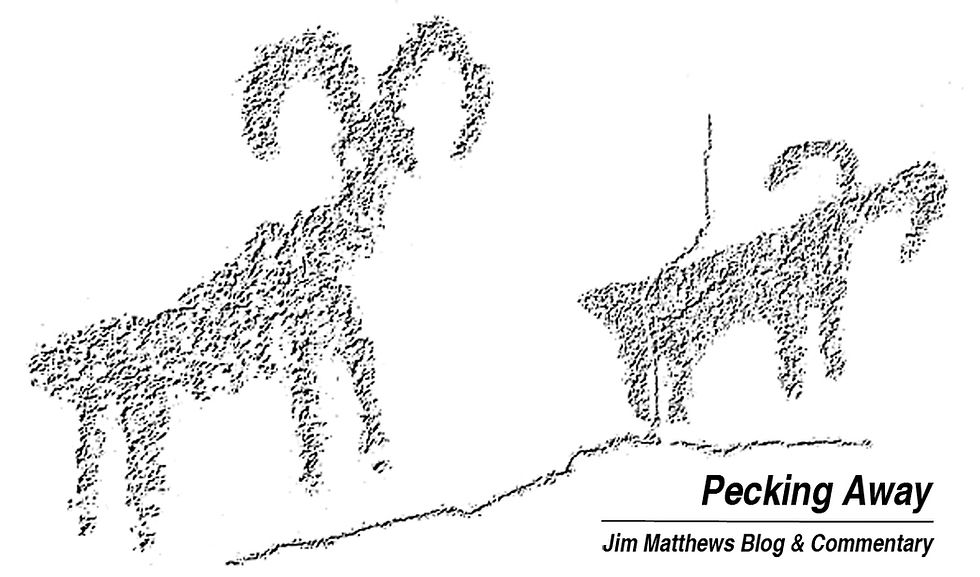Volunteers needed for bighorn census in San Gabriel Mountains
- Jim Matthews
- Feb 5, 2017
- 4 min read

By JIM MATTHEWS
www.OutdoorNewsService.com
Volunteers are needed for the annual bighorn sheep census in the San Gabriel Mountains conducted by the Department of Fish and Wildlife, with cooperation from volunteers, the U.S. Forest Service, and the Society for the Conservation of Bighorn Sheep. The count will be held all-day Sunday, Feb. 26, and there is a mandatory orientation meeting in Arcadia the evening before the census.
Surveys for bighorn sheep in the San Gabriel range have been conducted annually since 1979, most conducted with a combination of ground counts done by volunteers and a helicopter count done by DFW staff. The double count done at the same time allows the DFW to do very precise population estimates. The San Gabriels once held an estimated 740 sheep, which made this the largest population of desert bighorn sheep in California. The counts showed the bighorn population declined more than 80 percent through the 1980s, down to a low of under 100 animals. The sheep numbers have been rebounding in recent years, and the estimate from the most recent surveys places the number at about 400 sheep.
The DFW is anxious to have good weather for this year’s count because foul weather has hampered the survey in recent years, either preventing aerial counts or limiting the ground counts. This has made for population estimates that aren’t as precise.
This year’s sheep count volunteers will hike to designated locations throughout the San Gabriel Mountains from the Lytle Creek drainage west through the San Gabriel River drainage. Each group of volunteers will leave early Sunday morning and be headed up by staff from the DFW, forest service, or Sheep Society. All participants must be at least 16 years old and capable of hiking one mile in rugged terrain, although most survey routes are longer. Most hikes into observation areas will not be on maintained trails, and accessing survey points will involve scrambling over boulders, climbing up steep slopes, and/or bush-whacking through chaparral.
All volunteers are encouraged to bring binoculars or spotting scopes in addition to hiking gear. Because the weather can be unpredictable this time of year, participants should be prepared to spend several hours hiking and additional time making observations in cold and windy weather. Volunteers will need to start hiking early Sunday morning.
The mandatory orientation meeting for volunteers will be 6 p.m. Saturday (Feb. 26) evening at the Angeles National Forest headquarters office in Arcadia. Volunteers can sign up online at www.sangabrielbighorn.org or call 909-584-9012 to request a volunteer packet.
Federal lead ammo ban phase-in
is just for National wildlife refuges
and not likely to be implemented
The day before the inauguration of President Donald Trump, outgoing director of the U.S. Fish and Wildlife Service, Dan Ashe, issued an order that non-toxic ammunition and fishing tackle be phased in “to the fullest extent practicable” on all USFWS lands by January, 2022.
The order is not for all federal lands, which has been misreported in some circles. It only applies to federal wildlife refuges. In Southern California there are five refuges where hunting takes place; the Kern National Wildlife Refuge, the Sony Bono Salton Sea National Wildlife Refuge, and three refuges along the Colorado River, which also have fishing, Havasu, Cibola, and Imperial. Non-toxic shotgun ammunition is already required at all five.
It is unclear whether or not non-lead big game ammunition and fishing gear will be mandated on these refuges in the coming months.
While the Ashe order could be rescinded immediately by the new administration, the rule will terminate on its own July 31, 2018 if it is not incorporated into the Fish and Wildlife Service Manual (unlikely under the new administration), or if the new director does not “amend, supersede, or revoke it” by that date.
The statewide lead hunting ammunition ban in California is being phased in since its passage in 2013 by the legislature. It will go into full effect -- with a lead ammunition banned for all hunting -- for the 2019 hunting seasons, and the state’s rules will apply to hunting on federal lands within the state.
Like it or not, science-based or not, California hunters will be shooting non-lead for all game two hunting seasons from now.
Eighty percent of deer hunters
report tag information to DFW
The Department of Fish and Wildlife reported that it surpassed its goal of getting 80 percent of deer tag holders to report their hunting success for this past year’s hunting seasons, according to Craig Stower, deer program manager for the DFW.
There were a total of 176,491 deer tags issues for the 2016 seasons. Of those, hunters returned or filed on-line reports for 147,376 tags for a total of 29,115 tags not reported. The DFW says that since hunters can have two tags, there were a total of 23,238 hunters who did not report. The total reporting rate was 83 percent.
Last hunting season was only the second year that all deer hunters were required to report their hunting success by returning their tags or going on-line to do the reporting. Those not reporting will have to pay a “fine” of $21.60 before they can apply for deer tags for the 2017 seasons.
END
[Jim Matthews is a syndicated Southern California-based outdoor reporter and columnist. He can be reached via e-mail at odwriter@verizon.net or by phone at 909-887-3444.]























Comments